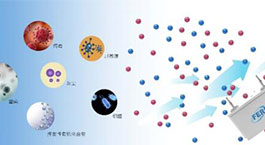 Your current location: Home > Technical Support > Popular Science Column > Fermion's 100 Q...
Your current location: Home > Technical Support > Popular Science Column > Fermion's 100 Q... This question has a wide range, because the ultimate vacuum that each material can achieve has a lot to do with the environment and state of the material, and cannot be simply discussed based on the material.
Take a simple example, water. The figure below shows the saturated vapor pressure of water at different temperatures. (Saturated vapor pressure refers to the pressure when the gas and liquid are in two-phase equilibrium. This concept has very important applications in the vacuum field, including in the field of molecular beam epitaxy)


8. What are the commonly used vacuum metal and non-metal materials, and how to choose them?
Common metal materials
● Stainless steel 304, 316, 316L, 316 LN
The most common material, structural parts below 600℃, simple processing, and controllable cost.
● Oxygen-free copper, beryllium bronze, phosphor bronze
Oxygen-free copper is generally used for low-temperature heat conduction or gaskets, and can work from extremely low temperatures to about 500°C, but it is not suitable as a structural part in high-temperature areas because its strength is greatly reduced.
Beryllium bronze and phosphor bronze are characterized by great hardness and wear resistance, so they can be used as bearings or wear-resistant parts inside the vacuum.
Beryllium bronze is also used in the manufacture of many shrapnel and pins due to its elastic characteristics.
● Tantalum, molybdenum, tungsten, titanium
These are all high temperature resistant metals. According to the degree of high temperature resistance, the arrangement from low to high is titanium, molybdenum, tantalum, tungsten
In terms of processing difficulty, tungsten has the highest hardness and difficulty, molybdenum processing parts are relatively brittle, tantalum processing is similar to stainless steel, and titanium will stick to the knife as the temperature rises during processing.
In terms of corrosion resistance, titanium will form a dense protective layer on the surface and can be used in high temperature oxidation environments.
Molybdenum will form molybdenum oxide above 500℃ in the presence of oxygen, and molybdenum dioxide will biodegrade at high temperatures, which will cause the original parts of molybdenum material to corrode continuously in a high-temperature oxidizing environment.
Commonly used non-metallic materials
● Alumina ceramics
Alumina ceramics are widely used in vacuum environments because of their simple processing, especially low batch processing costs, and are generally used as insulating gaskets or high-temperature thermal insulation materials.
● Polytetrafluoroethylene
Polytetrafluoroethylene has very stable properties and is self-lubricating, so it is often used as lubricating and insulating components inside a vacuum. The maximum operating temperature of polytetrafluoroethylene can reach about 200°C, so it can meet the baking requirements of ultra-high vacuum.
● PEEK
Polyetheretherketone (PEEK) resin is a special engineering plastic with excellent performance. Compared with other special engineering plastics, it has more significant advantages, such as high temperature resistance of 260 degrees, excellent mechanical properties, good self-lubrication, chemical corrosion resistance, flame retardant, peeling resistance, wear resistance, strong nitric acid, concentrated sulfuric acid resistance, radiation resistance, and super strong mechanical properties. It can be used in high-end machinery, nuclear engineering, aviation and other technologies.
Compared with polytetrafluoroethylene, PEEK can be modified by doping to obtain many sub-materials with different properties, such as friction resistance, corrosion resistance, heat insulation, etc. The following is a property comparison table of common engineering plastics.

9. Why should the gear meshing of the sample holder be coated with molybdenum disulfide? Does it have any effect on the vacuum?
If the gear meshing is not properly lubricated, dry friction will occur, causing wear on the gear, which may cause damage to the gear surface, inability to transmit, or even jamming. Short-term high-speed friction may even generate a lot of heat, affecting the cooling effect of the sample rack.
Pure molybdenum disulfide is a black solid, layered crystal. Each atomic monolayer of the material is only bound by van der Waals force, which is weak and easy to slip, so it has good lubricity and can be used as a solid lubricant. Its melting point is 2375℃, and it sublimates at 450 degrees in an inert atmosphere. Therefore, pure molybdenum disulfide will not affect the vacuum degree when used in a vacuum.
Molybdenum disulfide, which is actually used as a lubricant, usually contains other additives such as grease and surfactants. According to the content of MoS2, it can be divided into



For quick-drying molybdenum disulfide spray, except for molybdenum disulfide, graphite and polytitanate butylene, the others are volatile organic substances. Therefore, after use in the atmospheric state, the organic matter will evaporate quickly, and the residue is only solid lubricants such as molybdenum disulfide and graphite. These solid lubricants have high boiling points and low vapor pressures, and will not affect the vacuum.


In summary, whether molybdenum disulfide affects vacuum depends on the type of additive. Greases with high boiling point and high vapor pressure must not be used in a vacuum, while those that are volatile and have no residue can be used in a vacuum.


